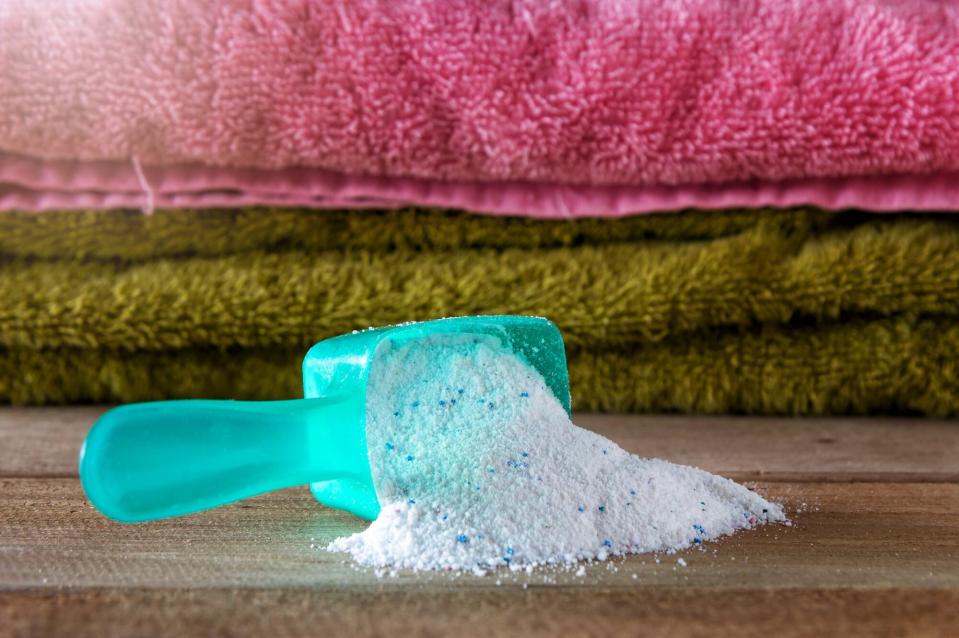Everything You Need to Know About Laundry Stripping – Including the Items You Should Never Strip
If you've been on any social media platform recently, you may have come across a video showing a method of laundry deep cleaning called "laundry stripping." The videos typically show a person's bathtub filled with water and everything from towels and sheets to stuffed animals floating in it. After pouring in several powdered cleaning products, the bathtub water slowly becomes a sludgy rainbow of gray, brown, and black, as the contents of the tub receive an extreme deep clean – it's both disgusting and oddly mesmerizing.
So, what is stripping laundry, exactly? This aggressive cleaning method is meant to strip heavily used items of built-up soil, laundry detergent, and fabric softener from assumed "clean" laundry, according to an article that Maytag published on the topic. Laundry stripping uses a combination of borax, powdered detergent, and washing soda, plus a hot water soak, as a chemical wash. Although it's a satisfying phenomenon to watch, the Maytag article warns that it's certainly not safe for all fabrics, and it's not necessary, if you wash your laundry correctly.
Much of the debris that clouds the water in this technique is leftover detergent and fabric softener that build up in fabric fibers overtime, according to the article. This build up can be avoided by using less detergent or fabric softener. You usually only need a tablespoon of detergent, which fills a detergent cap to the first line, for a normal load of laundry. Your detergent bottle will have specific washing instructions on the label.
Always check your item's care tag for water temperature requirements before you use this method on your clothes. Dark fabrics, workout clothes, and wool should also not be washed with this technique, according to the Maytag article.
Dark fabrics could potentially lose their coloring and leak dye into the water, while workout clothes, typically made of spandex, will not withstand the pH of the washing products used. Wool has a protective oil on it called lanolin, which is removed by the laundry stripping process, and would result in the fibers prematurely wearing down.
"Because laundry stripping uses hot water, it should also not be used on any garments whose care labels say to wash in cold water (the rule of thumb is that you can always go down in recommended temperature but should not go up in temperature!)," Sammy Wang, MS, Tide Senior Scientist, says.

Getty Images
Does stripping laundry work?
Eh, it's not so clear cut. "We do not recommend doing laundry stripping frequently as it can prematurely age and damage clothes," Wang says. "Laundry stripping also typically uses borax, which creates an alkaline condition, which can also further weaken natural fibers like cotton."
What items are safe to laundry strip?
Laundry stripping is most effective on light-colored towels and sheets because their size and bulk leads to more build up overtime, especially if they're not fully rinsed out in the washing machine, according to Maytag.
How can you tell if your laundry needs stripping?
Fabrics feeling sticky, or losing their softness or having distinct smells may be signs that they could use an extra deep clean because of hard water presence, Wang says.
Hard water is present in a majority of home plumbing systems in the U.S. "When hard water metals and body soils mix together, they can create fatty acid salts (like "soap scum") that can build up on clothes, creating tough odors or extra residues, especially if you're using a bargain detergent," Wang says. "High quality detergents like Tide contain chelants to help bind hard water metals, preventing the types of residues that are caused by hard water buildup."
How to Strip Your Laundry
Maytag advises against using your washing machine for laundry stripping. They also suggest using a long hot water soak in your washing machine with traditional detergent, followed by a rinse cycle before attempting the full laundry stripping process. If you find that your linens do need a longer soak, this is Maytag's suggested process:
Fill your tub with hot water.
Pour ¼ cup of Borax, ¼ cup of washing soda, and 1 cup of powdered laundry detergent into the tub.
Place your linens in the solution and stir.
Leave the mixture to sit overnight, stirring occasionally.
Drain the tub and rinse your linens in the washing machine on a rinse cycle only, or by hand until the water runs clear.
Dry clothes like normal.
Again, this process can only be used on certain fabrics and clothes items. You should always check your item's care tag before proceeding with this laundry method.
If you're looking for a way to avoid build up on your clothes, be sure not to use too much detergent or fabric softener in your loads. You can also add an extra rinse cycle to your clothes. Don't pack your washer more than three-quarters full, as this will ensure that all of the clothes in the load are thoroughly rinsed.
"If you are still interested in doing a laundry soak step for certain items, we recommend using a laundry product like 9 Elements that is designed to help purify fabrics from hard water buildup," Wang says. "To use 9 Elements Purifying Softener as a laundry soak, create at least a 1 to 10 mixture of 9 Elements Purifying Softener in room temperature water, and soak clothes for 20 minutes, stirring them around every 5 minutes.
"Then wash clothes in a washing machine cycle using 9 Elements Laundry Detergent and 9 Elements Purifying Softener," Wang says. "When used with 9 Elements Laundry Detergent, 9 Elements Purifying Softener is like a detox for your clothes, removing hard water residues and helping to soften fabrics and restore colors."
As satisfying as the laundry stripping internet trend is to watch, those murky waters could do more harm than good, so be sure that your sheets or towels are due for a long soak before taking the plunge.

